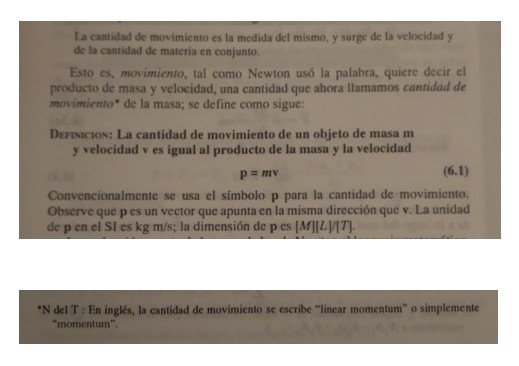-
Posts
916 -
Joined
-
Last visited
-
Days Won
3
Content Type
Profiles
Forums
Events
Everything posted by martillo
-
I think what we begun discussing with Genady also applies here:: dp/dt = F +vdm/dt If F = 0 then dp/dt = vdm/dt The change in momentum comes from the variation in mass. This would apply in Genady's example. No I don't get it. But you know, i think you are lagging behind. I'm going one step further with Genady, Swansont, may be Lorentz Jr. Please, give some time for this. If I go wrong in this we can return to your current point of view. Please, it's not easy to discuss with several ones at the same time. Please give me some time...
-
The Momentum and the Energy MUST be conserved ALWAYS! Let me try in your case. Just help me if needed please. You have p = mv dp/dt = F + vdm/dt where F= mdv/dt Conservation of momentum: p = constant if dp/dt = 0 Follows that the Principle of Conservation of Momentum is: Momentum p is conserved IF external forces F = 0 AND there's no variation in the mass: dm/dt =0. dp/dt = F + vdm/dt = if F = 0 and dm/dt = 0 Although the case F = -vdm/dt also verify it but I cannot imagine now an example for this... May be the law of conservation of energy must be rewritten too. I said, lot of problems to solve now. From scratch...
-
I was editing the post. May be you didn't see the last part now. You are right here that there is a problem with the current law of conservation of momentum. Consider my edition in the post: Note: p = mv dp/dt = mdv/dt + vdm/dt dp/dt = F + dm/dt and everything runs perfect! but F ≠ dp/dt and the problem is the consequences of this in Physics... Physics must be reviewed from scratch, from the review of the Newton Second Law... Don't you find this something good? I find it exciting, although lot of work... What could be better? 😄
-
You are right! No problem with this. It's just that as there are no forces and considering force = mdv/dt then the term mdv/dt = 0 and you have dP/dt = vdm/dt. But here you are also applying F = mdv/dt = ma even for a variable mass. That's the point F = ma ever. Is the definition of the force that really works. Note: p = mv dp/dt = mdv/dt + vdm/dt dp/dt = F + dm/dt and everything runs perfect! but F ≠ dp/dt and the problem is the consequences of this in Physics... Physics must be reviewed from scratch, from the review of the Newton Second Law... Don't you find this something good? I find it exciting, although lot of work... What could be better? 😄
-
You see, in the last step you arrive at Mdv/dt = αv and just say "this is the required force on the rocket". This is to consider that the force F is F = mdv/dt as everybody does. So the definition of the force that works on the rocket is F = mdv/dt = ma and not F = dp/dt. Just note that the mass M of the rocket alone is variable and so the formula F = ma is valid even for variable mass. The claim on the title of this thread stands.
-
No, I'm considering just the rocket now. The force on the rocket and the momentum of the rocket. Let us call Fr the force on the rocket and pr the momentum of the rocket. Then the force on the rocket is the thrust force: Fr = -vedm/dt and it must verify one of the two possibilities: 1) Fr = mar 2)Fr = dpr/dt For me and in the provided link (http://www.braeunig.us/space/propuls.htm) the first applies and agrees with Fr = mdv/dt. For you, as your definition of force is F = dp/dt, Fr must verify: Fr = dpr/dt. Now, dpr/dt ≠ ar for the variable mass m of the rocket so only one can be true. The rockets' Thrust Equation (mdv/dt = -vedm/dt) in which all of us agree shows that our first possibility is the right one. Your second possibility is wrong then. The rockets' dynamics shows that F = ma is valid and not F = dp/dt as the title of the thread says. The claim of the thread is right.
-
So you both agree that the Thrust Force is F = ma = -vedm/dt. Well, in the rocket the mass m varies then there is a problem because you both agree that even with a varying mass m is valid: F = ma and not F = dp/dt. I mean F = ma on the rocket and not F = dp/dt. dp/dt ≠ a when mass varies. Not necessarily, I agree.
-
Is the inverse: classical physics is a part of relativity theory when only slow velocities (in relation to c velocity) are present. What are you thinking on? If you think to calculate now the thrust equation and the thrust force from scratch I think I will not follow you. We all already had a lot of discussions in the thread. Please summarize in what you disagree with me.
-
The definition of momentum p in my Frank J. Blatt's book of Physics (Spanish version) is p = mv. Note: p is called "cantidad de movimiento" in Spanish and "linear momentum" or just "momentum" in English as mentioned in the foot note of the page (photo below). Here the photos of the definition section and the foot note of the page: N del T in the foot note means note of the traductor. The definition doesn't mention if the mass must be constant or not. It is said that the definition is a direct translation of the definition made by the proper Newton. I think Newton didn't considered the mass as variable so may be the original definition is valid for constant mass. In the link I provided for the page about rockets (http://www.braeunig.us/space/propuls.htm) the same definition p = mv is considered and it is worked with the variable mass of the rockets. The question of if the definition of the definition of P = mv applies to variable masses can be solved considering that if it is valid, then is valid the equation: dp/dt = mdv/dt + vdm/dt This equation is which I considered in my derivation of the Thrust Equation for the rockets in the description of the problem about the rockets we are discussing which is presented at the OP of the thread. I have made a search with google and found that the definition p = mv is valid in Classical Physics while in Relativity Theory the definition for momentum is p = γmv. The classic definition would apply then as the particular case of slow velocities (γ approximated to 1). I conclude then that all my treatment about rockets (including the provided link) is valid within Classical Physics but not within Relativity Theory.
-
Well, I think that in Classical Physics p is defined as p = mv and it is valid the equation dp/dt = mdv/dt + v dm/dt. This things valid for variable m because if not dm/dt would have not make sense. The Thrust equation for the rockets would have no sense. I must consider then that they are valid within Classical Physics only. Can I say that?
-
For the case of systems with mass, p is defined as p = mv whatever m being constant or variable. You are right that in the case of photons without mass but with energy, the definition is in terms of energy. I must point out that in Relativity there is a total correspondence between energy and mass by the equation E = mc2 and so it is not clear for me how photons can have energy and not mass but this subject goes beyond the scope of this thread. May be in other thread... As I said other place I'm not able to discuss in terms of Variational Calculus, I have no expertise at all in this area.



